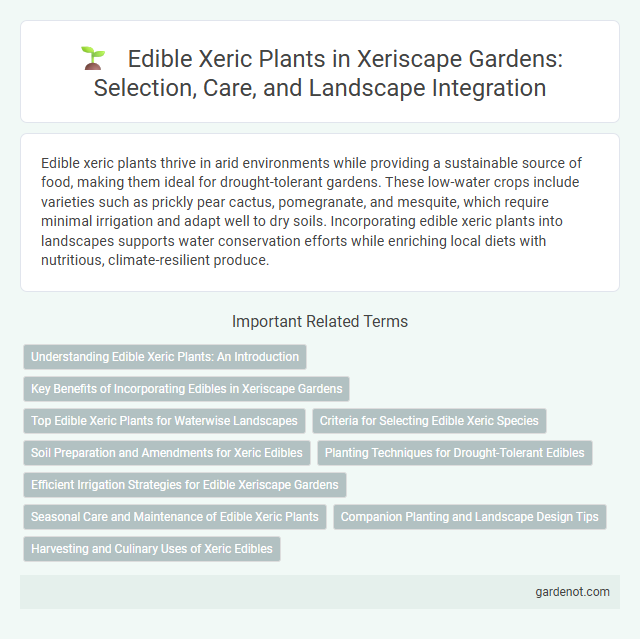Edible xeric plants thrive in arid environments while providing a sustainable source of food, making them ideal for drought-tolerant gardens. These low-water crops include varieties such as prickly pear cactus, pomegranate, and mesquite, which require minimal irrigation and adapt well to dry soils. Incorporating edible xeric plants into landscapes supports water conservation efforts while enriching local diets with nutritious, climate-resilient produce.
Understanding Edible Xeric Plants: An Introduction
Edible xeric plants thrive in arid environments by efficiently using minimal water while providing nutritious food sources such as prickly pear cactus, purslane, and mesquite pods. These drought-tolerant species are rich in vitamins, minerals, and antioxidants, making them valuable for sustainable gardening and dryland agriculture. Incorporating edible xeric plants into xeriscaping supports water conservation, enhances biodiversity, and offers resilient crops for regions facing climate challenges.
Key Benefits of Incorporating Edibles in Xeriscape Gardens
Incorporating edible plants in xeriscape gardens enhances water efficiency by utilizing drought-tolerant, nutrient-rich crops like herbs, fruits, and vegetables that thrive in low-water conditions. Edible xeric gardens promote sustainable food production while reducing irrigation needs, soil erosion, and chemical inputs. These gardens also improve biodiversity by attracting pollinators and providing habitat for beneficial insects.
Top Edible Xeric Plants for Waterwise Landscapes
Top edible xeric plants for waterwise landscapes include drought-tolerant species like prickly pear cactus (Opuntia), which produces nutritious fruit and requires minimal irrigation. Agave varieties offer edible hearts used for sweeteners and fermented beverages, thriving in arid conditions with low water needs. Mediterranean herbs such as rosemary, thyme, and sage complement xeriscape gardens by providing flavorful leaves while conserving water effectively.
Criteria for Selecting Edible Xeric Species
Selecting edible xeric species requires prioritizing drought tolerance, soil adaptability, and nutritional value to ensure sustainable growth in arid environments. Crop choices like prickly pear cactus, mesquite, and amaranth thrive under minimal irrigation while providing essential vitamins and minerals. Emphasizing native species supports local ecosystems and reduces water usage, aligning with effective xeriscaping principles.
Soil Preparation and Amendments for Xeric Edibles
Soil preparation for edible xeric gardens requires thorough assessment of soil texture and drainage to ensure optimal moisture retention without waterlogging. Incorporating organic amendments such as compost and aged manure enhances soil fertility and structure while promoting beneficial microbial activity crucial for drought-tolerant edible plants. Adding mineral amendments like gypsum or rock phosphate can improve nutrient availability and support robust growth in nutrient-poor xeric soils.
Planting Techniques for Drought-Tolerant Edibles
Implementing deep, infrequent watering helps edible xeric plants develop robust root systems essential for drought tolerance. Utilizing mulch conserves soil moisture and moderates temperature, creating a favorable environment for edible drought-resistant species like figs, pomegranates, and succulents. Strategic spacing ensures adequate airflow and reduces competition for limited water resources, optimizing growth and yield in xeriscape gardens.
Efficient Irrigation Strategies for Edible Xeriscape Gardens
Efficient irrigation strategies in edible xeriscape gardens prioritize drip irrigation systems and soil moisture sensors to minimize water waste while ensuring optimal hydration for drought-tolerant edible plants like herbs, succulents, and native vegetables. Mulching with organic materials such as straw or wood chips reduces evaporation and maintains consistent soil moisture critical for plant growth in arid climates. Selecting deep-rooted edible species combined with scheduled, low-volume watering enhances water-use efficiency and promotes healthy, productive xeric food gardens.
Seasonal Care and Maintenance of Edible Xeric Plants
Edible xeric plants require minimal water but benefit from seasonal pruning to promote healthy growth and fruit production. Mulching helps retain soil moisture and suppress weeds, while periodic soil testing ensures nutrient balance tailored to the plant's needs. Monitoring for pests and diseases, especially during warmer months, is crucial to maintain plant health and maximize harvest yield.
Companion Planting and Landscape Design Tips
Edible xeric gardening emphasizes companion planting techniques such as pairing drought-tolerant herbs like rosemary with pollinator-friendly flowers to enhance growth and pest control. Integrate native succulents and hardy fruit shrubs in landscape design to maximize water efficiency while providing nutritious yields. Strategic plant placement ensures optimal sun exposure and soil moisture retention to support resilient, sustainable edible landscapes.
Harvesting and Culinary Uses of Xeric Edibles
Xeric edibles such as prickly pear cactus, agave, and mesquite pods offer drought-resistant harvesting opportunities, providing nutrient-rich fruits and seeds ideal for sustainable food sources. These plants require minimal irrigation and thrive in arid climates, delivering flavors ranging from sweet prickly pear fruit to nutty mesquite flour, widely used in Southwestern cuisine. Incorporating xeric edibles into culinary dishes enhances flavor diversity while supporting water conservation efforts in agriculture.
Edible xeric Infographic

 gardenot.com
gardenot.com